
Welcome to our 10th Anniversary edition of the InARTE Journal. Works featured in this year’s publication present a diverse understanding of the theme of transformation. Many undergraduate students from across Concordia’s Faculty of Fine Arts submitted impressive work in visual, written, and immersive formats. Throughout this academic year, I, along with my fellow team members, started to see our theme come to life through the paintings, videos, and papers we received for our consideration. Transformation was often reflected upon as ever-changing; free of a beginning, middle, and end. It is for this reason that we chose to name our 10th issue, “In Flux”.
We as a society have experienced several changes throughout this past year, especially within the last few months as the impact of COVID-19 began to be felt around the world. I hesitate to comment on the synchronicity of our chosen theme alongside the current global situation. In fact, our theme was chosen in the summer of 2019, with the intention to encourage reflection as we reach this memorable anniversary for our Journal. I am endlessly thankful that we have – and delighted that we publish our annual issues of the journal in a socially and environmentally sustainable online form. In recent weeks, responding to the University’s temporary closure of its spaces and cancelling of all events, the InARTE team and I have restructured our plans to host an on-campus exhibition this spring, showcasing the exceptional work featured in our 10th issue. And so, along with the publication of our 10th issue, on April 21st, 2020, the exhibition went virtual for three months using the online platform Kunstmatrix.
This special two-part anniversary project was made possible by the efforts and creativity of my team members: Morgane Poezevara-Stevens as assistant editor, Nora de Mariaffi as the event coordinator, Jean-Philippe Poirier as graphic designer, Aná Luiza Costa Dafre as social media coordinator, Tricia Enns as managing editor, and with support from our Faculty Advisor, Kathleen Vaughan. Each of us brought unique perspectives to each team meeting and provided continuous motivation.
As you discover this year’s issue you will see quite a diverse selection of work; each piece shining with a unique brilliance. The artists featured in our issue and virtual exhibit, “In Flux,” capture a range of the emotions and thoughts felt while going through stages of transformation and continuous change: peace, turmoil, confusion, and recollection, to name just a few. This collection of work is a sincere manifestation of experience in many states of flux. The virtual exhibition for our 10th issue ran from April 21, 2020 and ended on June 23, 2020. We are very grateful that we were able to share the excellent work that is included in our anniversary issue, with the fine arts community at Concordia University and the greater community in Montreal.
If you missed the chance to interact with our exhibition, take a look at a few pictures of what it looked like below!
Sincerely,
Sylvia Erlichman-Gross
4th Year, Major in Art Education & Minor in Judaic Studies
Editor of the InARTE Journal 2019-2020

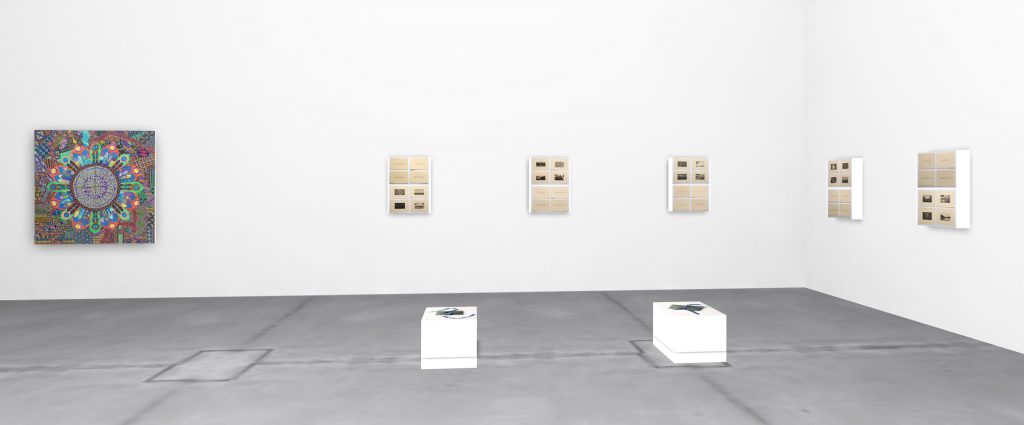
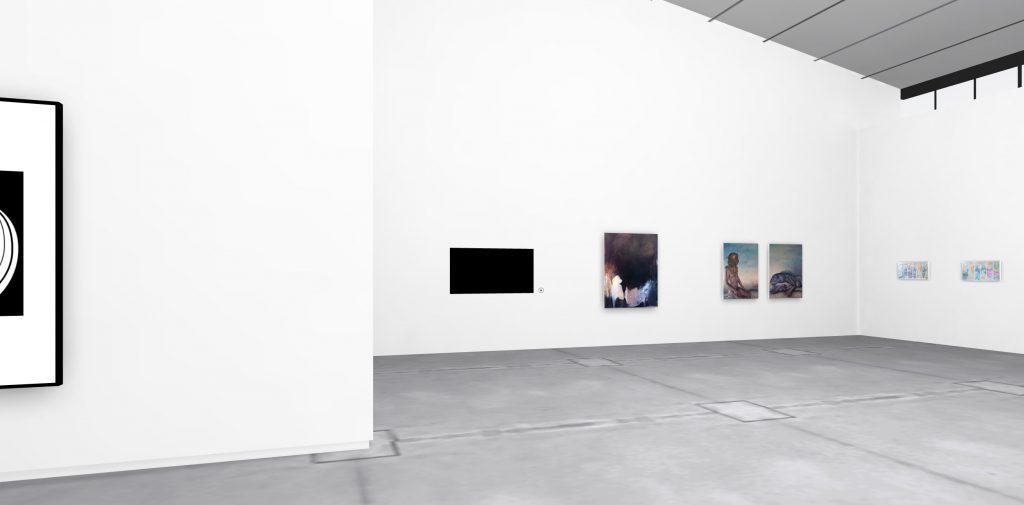
Allison Brown
4th year, Major in Film Animation
The Inbetween
Duration: 2:23
Digital 2D Animation 2048 x 1080
Music arranged by Nenad Mićanović
2019
Artist Statement:
The Inbetween is an animated short illustrating the point in a young adult’s life where they accept that they have outgrown their childhood home. Not that they can never return, only that it will never be the same as when they were small. In the film, a girl outgrows her home and leaves for a new one where she might fit. Upon arriving, she realizes she may have some more growing to do before this new home suits her.
The idea for this film arose at a time when I was feeling an inexplicable sense of loneliness and confusion about my future and a homesick nostalgia for my childhood. I didn’t want to move back to my hometown; it felt so different now, from when I was a teenager. And I didn’t want to be in Montréal in my apartment because I didn’t feel like I was old enough or “ready” to be taking care of myself completely. I wanted to either go back in time, or fast forward to a future where I would be and feel more secure.
The Inbetween is for those who leave their childhood home feeling larger than life, to pursue an ambition, or simply for a change of scenery. I expect the audience to reflect on their personal intermediary stages, as well as their experience of leaving home and returning back for the first time after being out on their own. This is all to say, I think we’re all a bunch of little giants just trying our best to grow and figure it out.
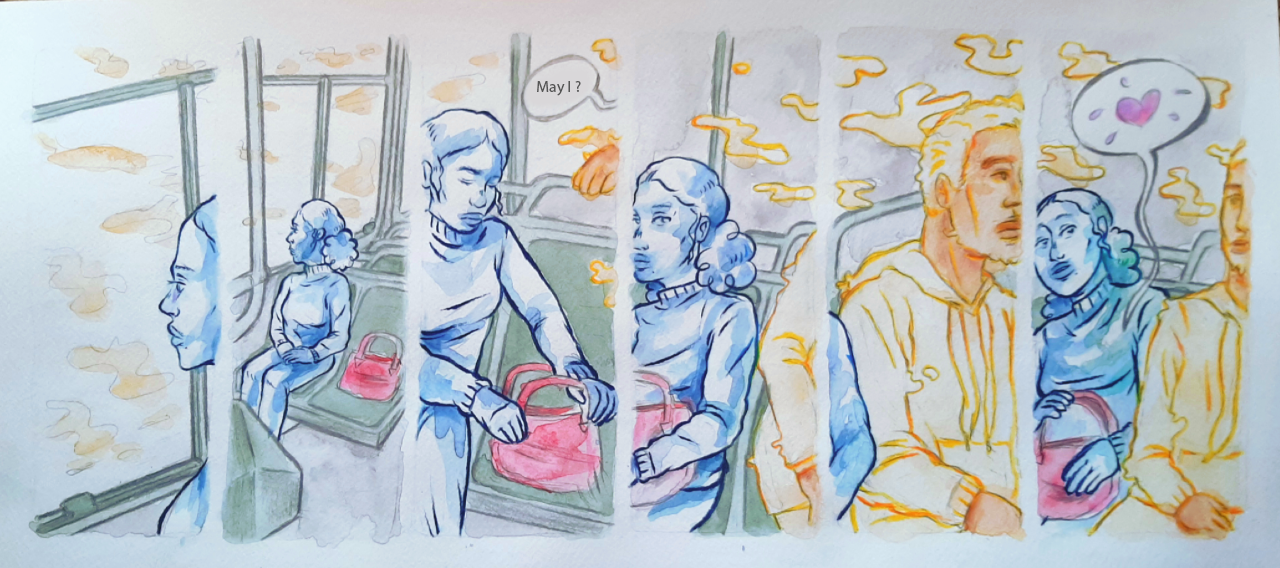
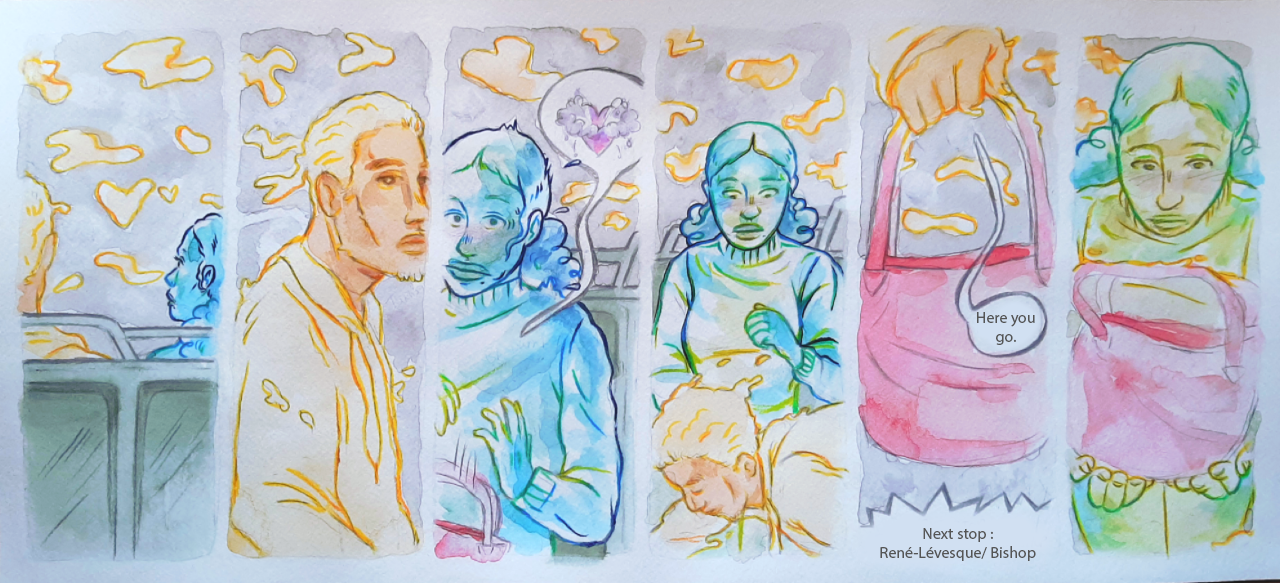
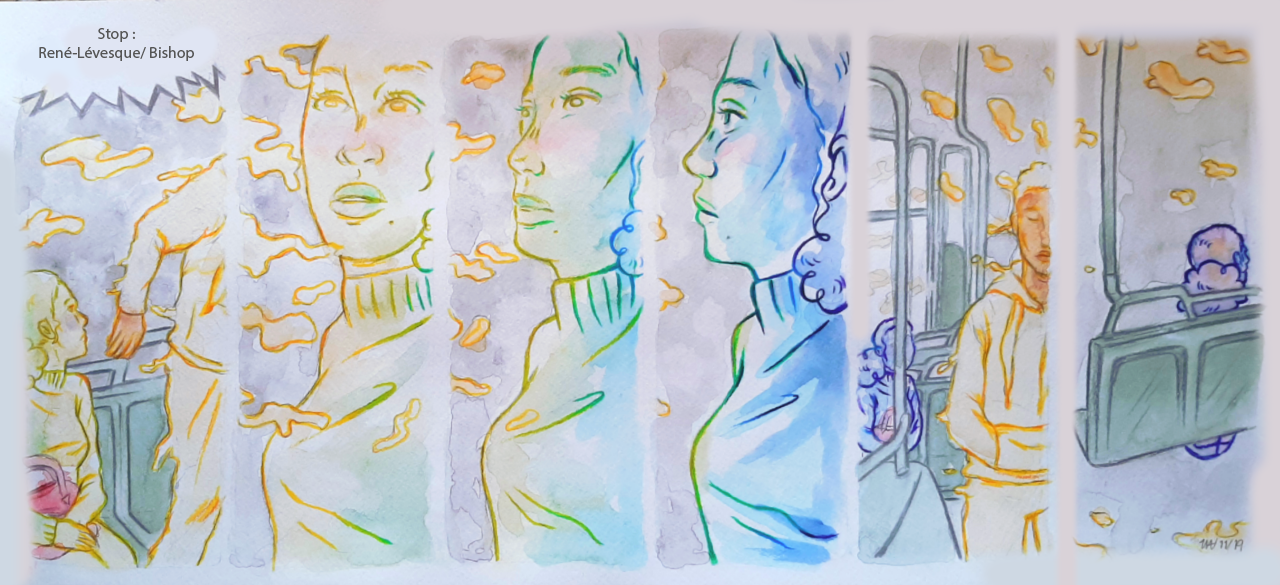
Wendy-Alexina Vancol
3rd Year, Major in Studio Arts
Daily Butterfly Commute
10″ x 20″
Water and coloured pencils on cold press paper
2019
Artist Statement:
Like many, I depend heavily on public transportation to get around. Since my school and job are far from where I live, I have accumulated quite the mileage over the years and have often been asked, “Why don’t you just avoid all the trouble and get a car already?” The thought of driving has crossed my mind more than once. In fact, the ability to drive would cut my traveling time in half and would allow me to avoid the harsh Montreal climate. However, my reasons for choosing not to drive go beyond my laziness to complete my driver’s permit and my lack of a car. Somehow all of those hours spent travelling in the bus have made me develop this odd fondness for the interactions which come with travelling alongside strangers. Whether it is helping an elder with their grocery bags or giving directions to a stranger, I have come to appreciate those little interactions as they brighten up any gloomy or uneventful day. Daily Butterfly Commute is a three-page comic strip about the sometimes-brief encounters we have while taking public transportation and the non-verbal modes of communication which can also occur during these happenstances. The title of this piece is inspired by the butterfly effect phenomenon, which is based on the idea that even something small is powerful enough to make big changes.
In the case of my comic, the man is a representation of the butterfly who flies out of the woman’s life as fast as he came in. The brief encounter between the two alters the woman’s mood; thus, unknowingly reviving her longing for more interactions. Throughout the years I have drawn many comics that have featured a variety of fictional characters and stories. Although I am the sole author and artist of those stories, I have always had a hard time situating myself as the protagonist, as I never considered my unvarying life to being exhilarating enough to base an entire story on. When drawing, in order to help my mind form a realistic image for the situations in which I imagine my characters in, I tend to physically enact the scenes. To my surprise, me doing so has resulted in my family and peers seeing my characters I drew as being a spitting image of myself and not being able to separate the two. Although that was not a part of the initial process, I will admit that the process of making comics has been a guide for me to dig into my inner psyche. The work has actually given value to all the experiences I live through as they are what formed me into the person I am today.
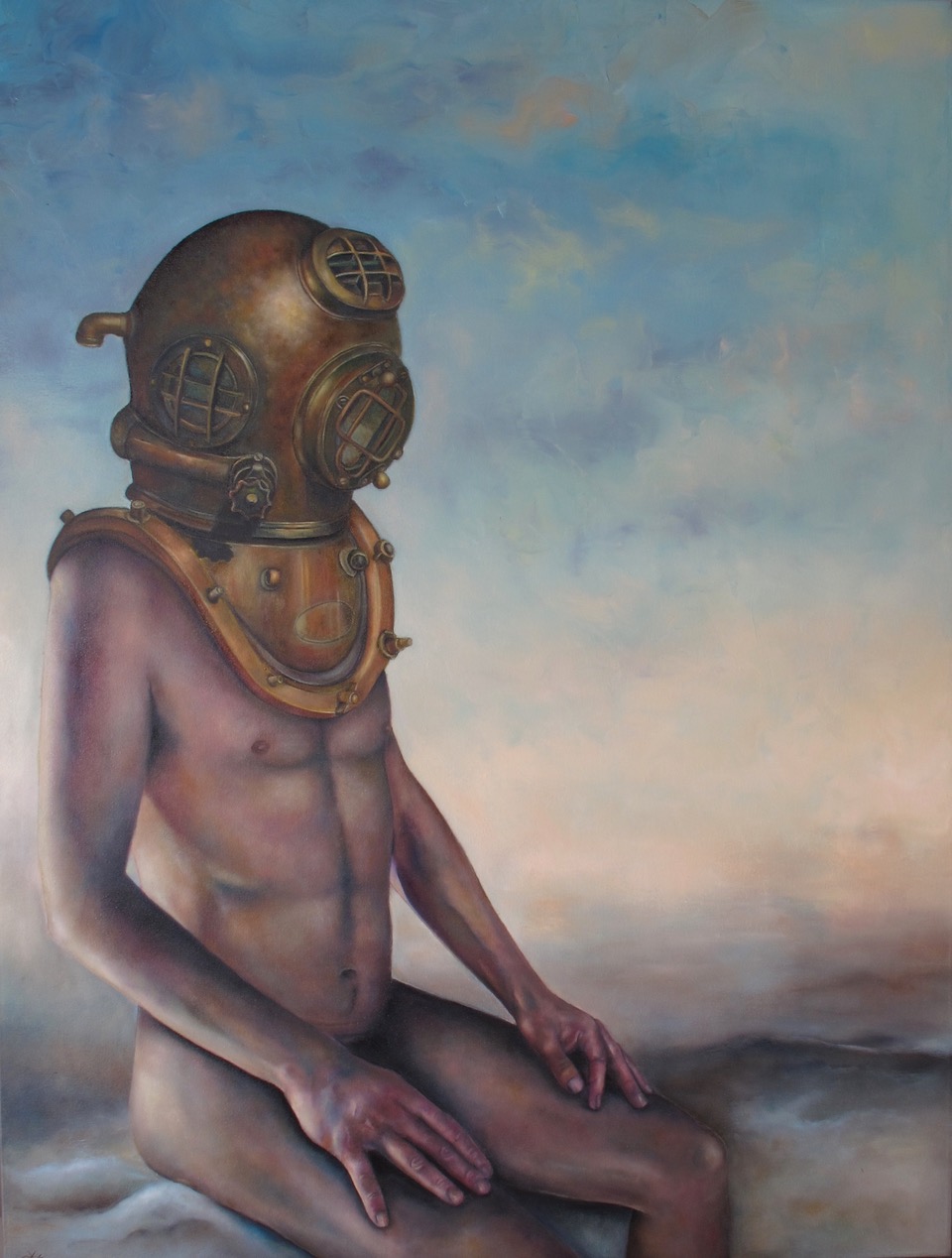
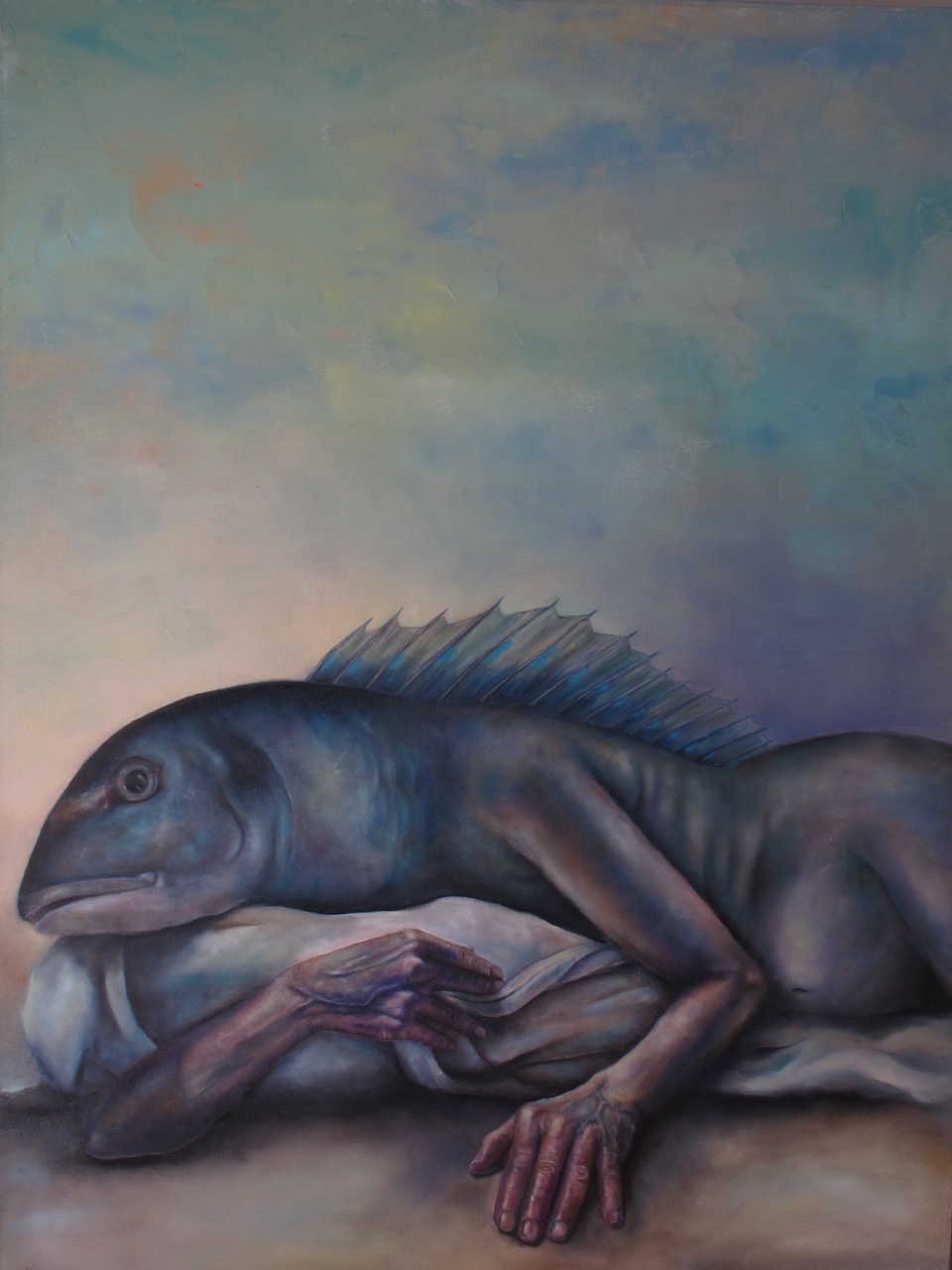
Sonya Kertész
Cinquième Année, Majeure en Peinture et Dessin
Sea Shepherd & Fish Woman
Chaque 36″ x 48″
Huile sur toile
2016
Artist Statement:
Étant plongeur depuis plus de 25 années je me suis inspirée de mes idées que m’apportent mes plongées pour produire ce diptyque. Dans ce travail artistique je tente judicieusement de recréer pour le spectateur une atmosphère propice à la détente ou à l’inverse créer un moment inconfortable et dramatique. Je cherche à faire vivre une expérience d’immersion unique à l’observateur en le projetant dans un univers qui est difficile d’atteindre tel que le monde sousmarin. C’est donc dans le cadre du cours de painting 200, à partir de modèles vivants, j’ai créé un diptyque masculin et féminin. J’ai reproduit en classe les corps nus des modèles pour ensuite faire appel à ma créativité en modifiant leurs têtes. Mon intention était de représenter une transformation et/ou une mutation des êtres vivants pour nous rappeler cette ère dans laquelle nous vivons qu’on appelle Anthropocène.
Dans ma façon de procéder, je débute par un lavis en utilisant beaucoup de solvant. Les toiles sont toujours réalisées par l’accumulation de plusieurs couches subséquentes de peinture en prenant le soin de laisser sécher entre les couches. Enfin, les diverses couleurs fabriquées à l’aide de plusieurs tonalités et appliquées avec des pinceaux de différentes tailles ont pour but de rechercher des combinaisons de couleurs dichromatiques.
Une des scènes du diptyque représente Sea Shepherd; l’homme à la tête d’un scaphandrier doté d’un corps fort musclé assis calmement au fond des mers et qui pose un regard veillant et inquiet sur une femme à la tête d’un poisson (2e scène). Fish Woman, à la chair bleutée tel une carcasse affaiblie est allongée avec un regard mélancolique, dans lequel son état de mutation semble souffrant et agonisant. L’accent et les détails des tableaux sont portés sur les mains des deux personnages pour évoquer les liens qui nous unissent entre les hommes et les femmes. Les couleurs des arrière-plans sont claires et lumineuses afin de susciter l’espoir. Dans mes œuvres je cherche à représenter la beauté de l’univers marin mais qui parfois amène aussi un côté beaucoup plus sombre. Depuis les dernières années lors de plongées, j’assiste à un spectacle d’innombrables déchets tels que les bouteilles de plastique, des sacs, des détritus de toutes sortes. Ces observations me bouleversent et m’amènent sur la question de l’Anthropocène; celle où les activités humaines ont eu un impact global significatif sur l’écosystème. C’est d’ailleurs pourquoi l’intention de mes œuvres est de présenter ce qui est plein d’attirance ou de répulsion, dramatique et/ou grotesque, vivant ou sans vie, rare ou multiple. Ces différentes dualités exprimées dans mon travail cherchent notamment à attirer et repousser le spectateur. Finalement, l’un des objectifs principaux réside dans la sensibilisation et la conscientisation de la population à la fragilité et la survie de nos océans.
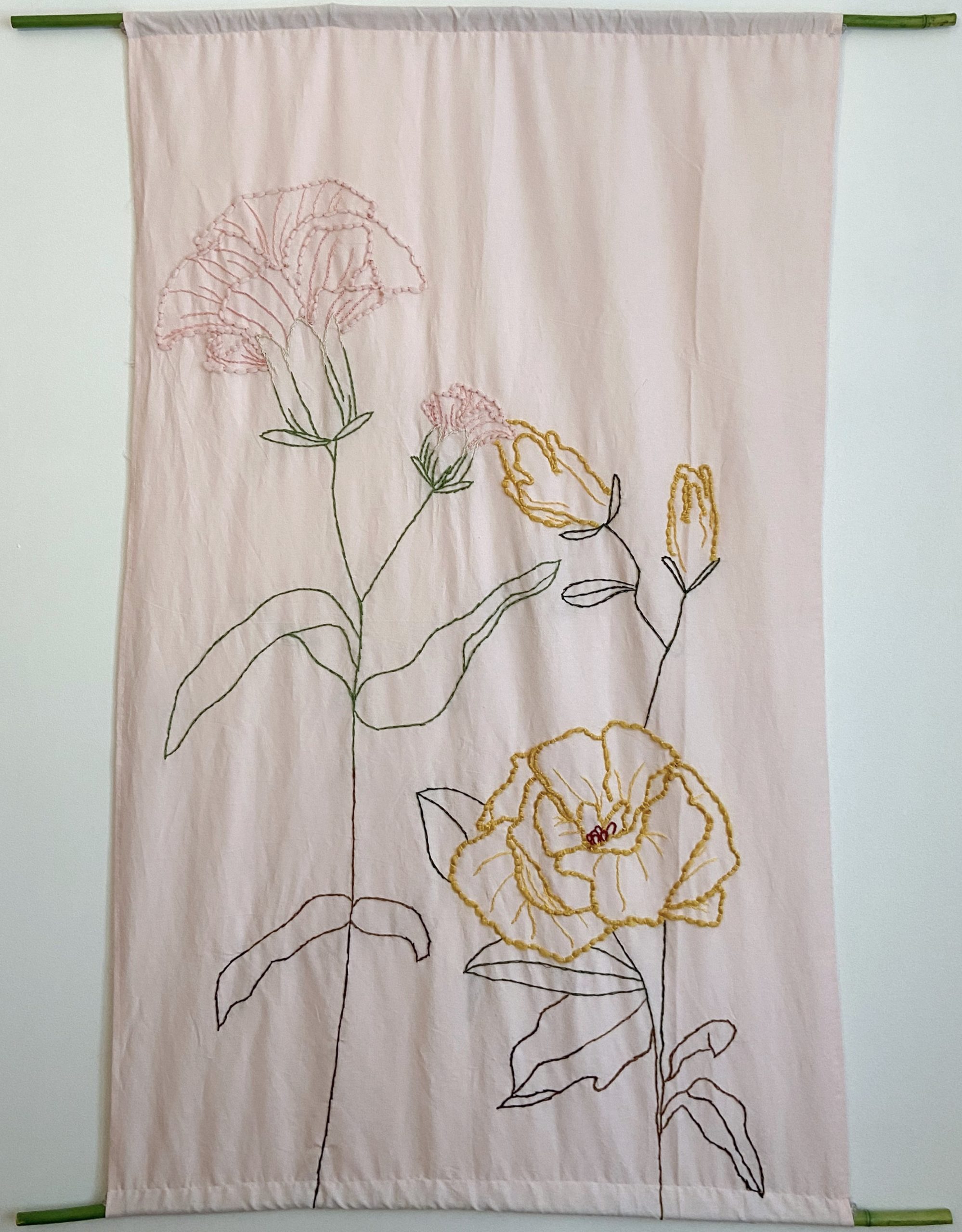
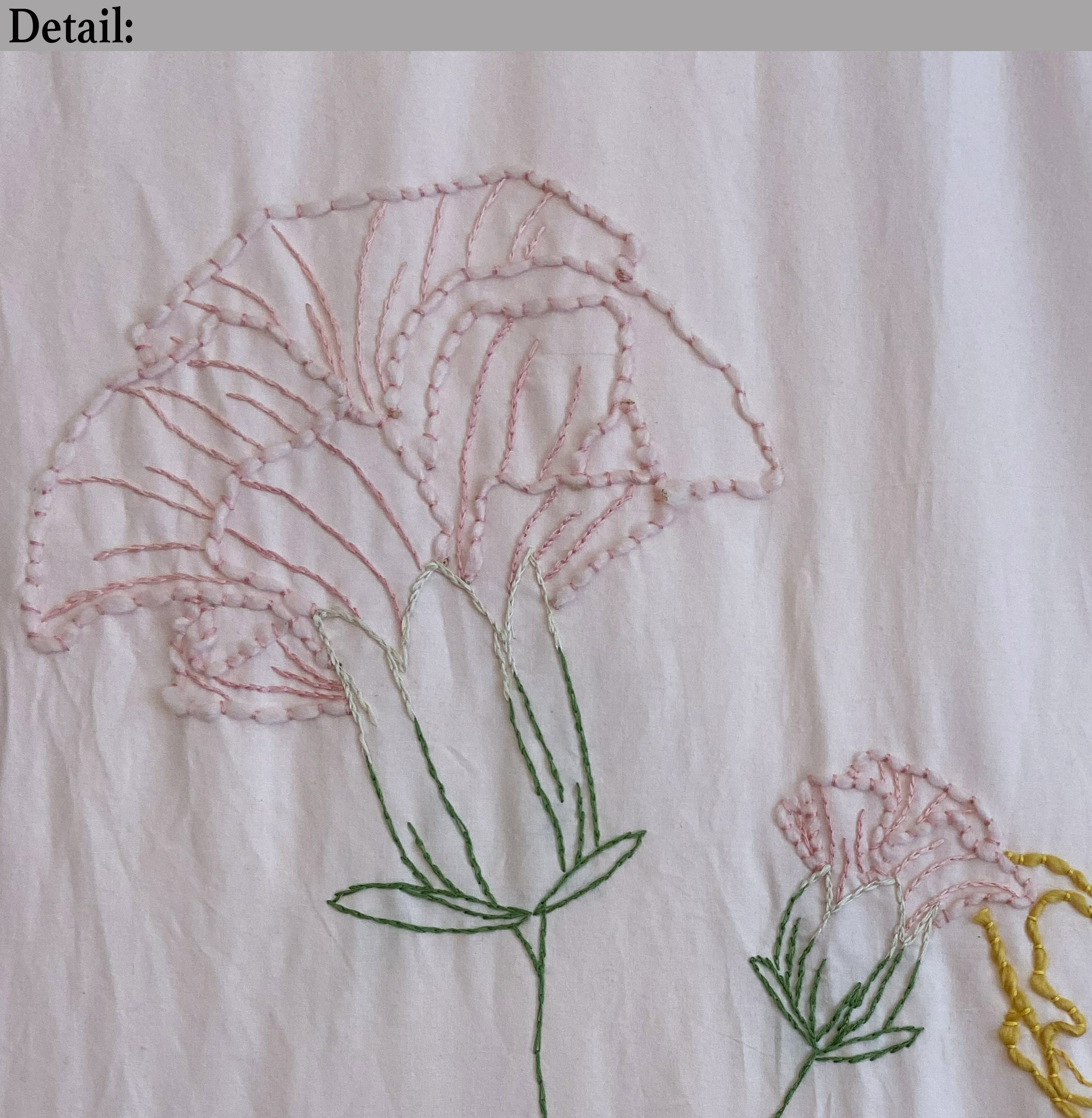
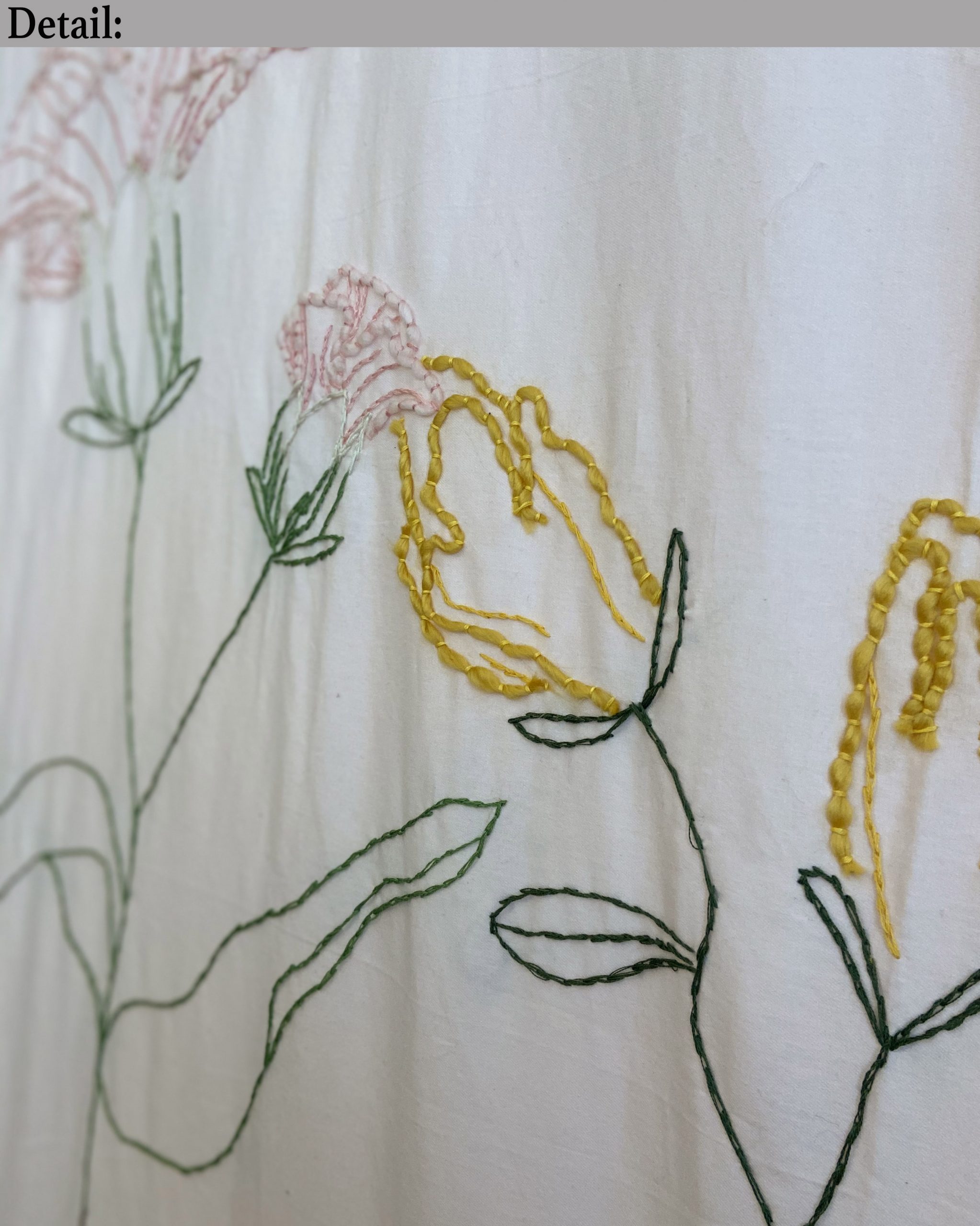
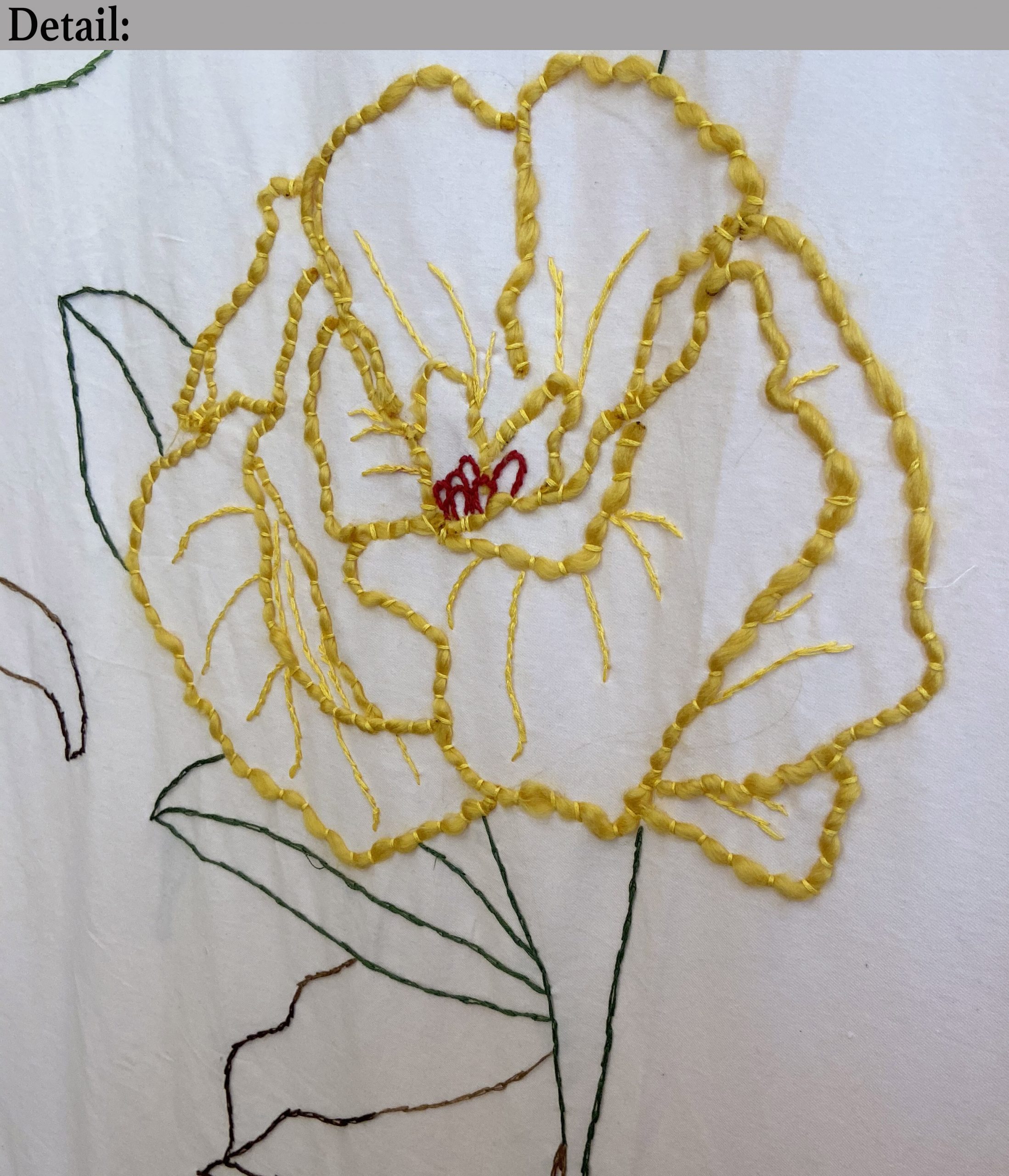
Sarah Pearson
3rd Year, Major in Art Education & Minor in Psychology
Growing Pains
40″ x 55″
Embroidered Textile
2019
Artist Statement:
I believe that creating and sharing art is a very intimate practice, which is the reason why the majority of my artwork draws from my personal narratives and experiences. I aim to make art that is expressive and evocative, exemplifying various emotional states and the self-awareness which exists alongside. This is in hopes that the viewer feels immersed in or connected to my artwork in a personal way. I value colour and the power it has in setting the tone of an artwork as well as directing the viewer. This is something that guides my process; therefore, colour is an integral element of my art practice and the colour palette of this work was an essential component in creating a warm and inviting artwork that greets the viewer. I view the definition of growth to be synonymous with aspects of community. Similarly, the visual of plants and flowers growing has remained in the back of my mind since the beginning of my journey in community art education; a visual metaphor for the significant life experience of learning how to teach and facilitate the learning and making process for others. Being so privileged as to work with such a broad range of populations throughout my professional experiences and within my teaching placements, has taught me about the fragility of older learners as well as young children and youth who are very impressionable at that age. Teaching experiences with these populations have shed light on the amount of vulnerability it can take to create, share, and engage with art. These thoughts surrounding growth and vulnerability are the reasons behind my choice to work with such an intricate fibres technique, embroidery.
Ideas of delicacy and fragility bring a whole other dimension to the narrative of growth. Elaborating on the notion and representation of natural objects, I felt it important to capture organicity as well as elements of degradation. I included elements of degradation in this piece as reference to hindrances I have experienced both as an artist and an educator, and how I have grown and transformed my perspective when looking back at those experiences. These elements in this artwork are equally indicative to any obstacles learners of mine have had to overcome and how they’ve done so through artmaking and learning processes. Growth, learning, and art making are profoundly intertwined in the field of art education and within my own thinking. After all, growth is not linear, and neither is learning; they are natural processes which take place over time and require much hard work and reflection. For this reason, this visual metaphor is something I plan on expanding on in my future artistic practice as well as bringing similar concepts forward in the lessons I will develop. This is in hopes of opening up the conversation surrounding the importance and authenticity of growth in community.
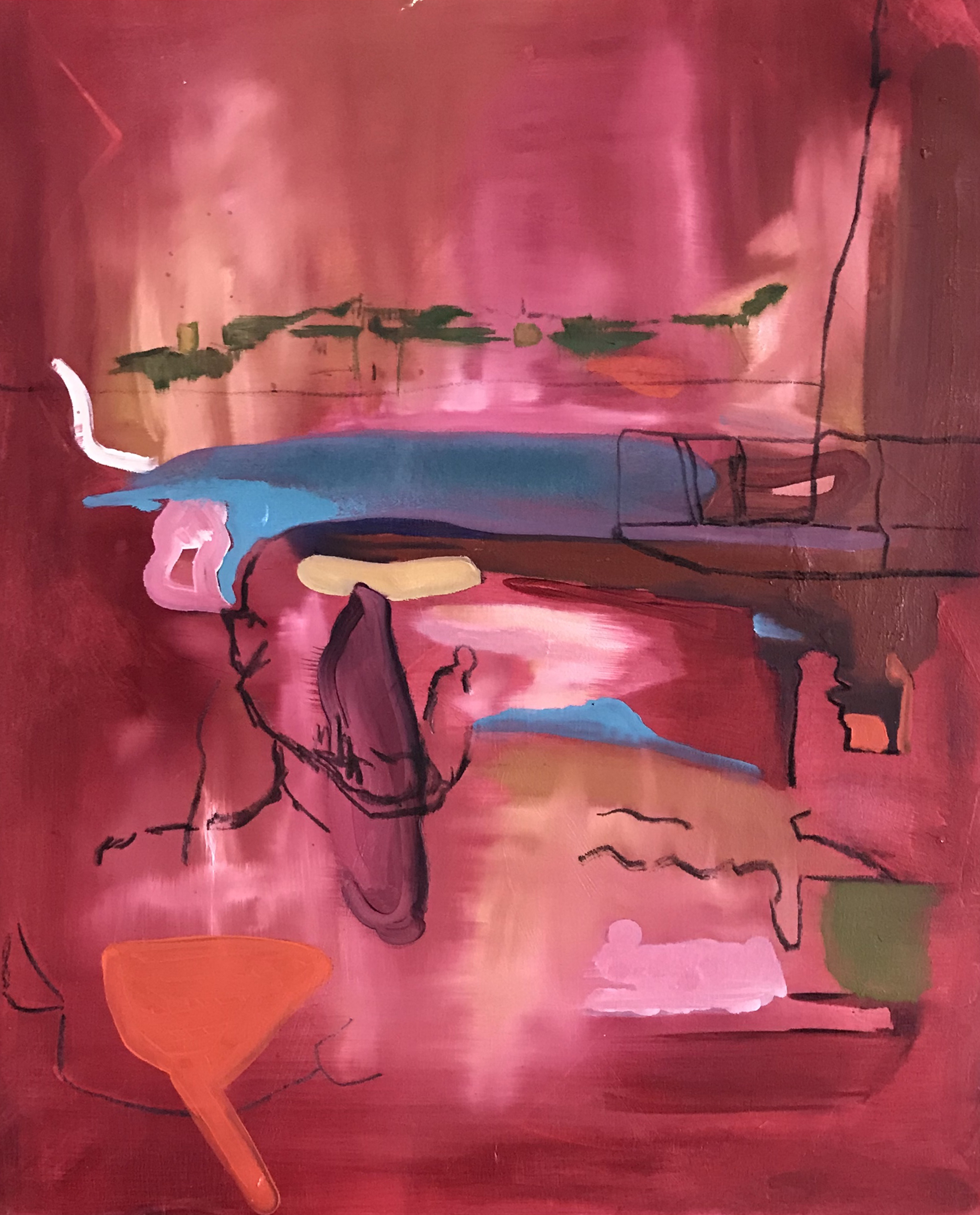

Rosi Maria Di Meglio
4th Year, Double Major – Art Education, Painting and Drawing
Porte D’Ischia I
16″ x 20″
Oil on wood
2017
Porte D’Ischia II
8″ x 10″
Oil on linen
2019
Artist Statement:
This series started as a research project, delving into my identity as an artist born from immigrant parents. I have never really felt I had a clear hold on my identity; digging deep and questioning why has become a clear goal of mine; wishing to uncover the roots of my identity. I began this research project by revisiting my past: my childhood, my adolescence, and my past marriage. I revisited these elements through memories and photographs.
This research deepened when I visited my parents’ hometown in Ischia, Italy, for the first time in 2016. I felt that I needed to discover this heritage of mine, my parents’ way of life in their hometown, to fully discover and see my own identity. I met my aunts, uncles, and cousins who I never knew I had. I was able to piece together and ultimately better understand my heritage and myself. I was able to recognize my parents’ way of life back in their own hometown and understand the differences between Canadian and European cultures.
These two paintings are part of a larger ongoing series exploring space and identity. Both paintings are reflections from my visit to Italy in 2016, depicting my experience at the Porte of Ischia, where locals still purchase fresh fish from the fishermen as they have done for centuries, and where I shared many memorable moments with my Aunt Fiorina.
My work begins through the lens of a camera; I believe it is important that my work derives from original photographs and memories. I then deconstruct and transform the photos I take and memories from that moment into an abstract painting filled with expression and movement. I use intuition to decide on colour, composition, and a layering process; these elements are made to grab the viewer into the canvas and transport the viewer. While articulating the thought process as it pertains to certain colours I used in my paintings is difficult, I can identify that my colour choices respond to memories of the naive girl I once was, with my use of pink and red tones; and in the green painting, with earth tones reflecting my healing process. The translucent appearance develops from layering thin layers of paint. The layers reveal shapes and forms that fascinate me because they are not part of the original composition. These shapes and forms rise to the surface and speak of uncertainty and wonder. The push-and-pull of the canvas between the foreground and the background is intriguing because it leaves me with a sense of space between these two grounds and the multiple layers that exist in between.
I chose to place these two paintings side by side because together they speak of a time of discovery and transformation for myself: an enlightening about my identity. They are inspiring and take me to a place where I feel safe and free. Together these works represent the transformative experiences I lived through, to become the woman I am today.
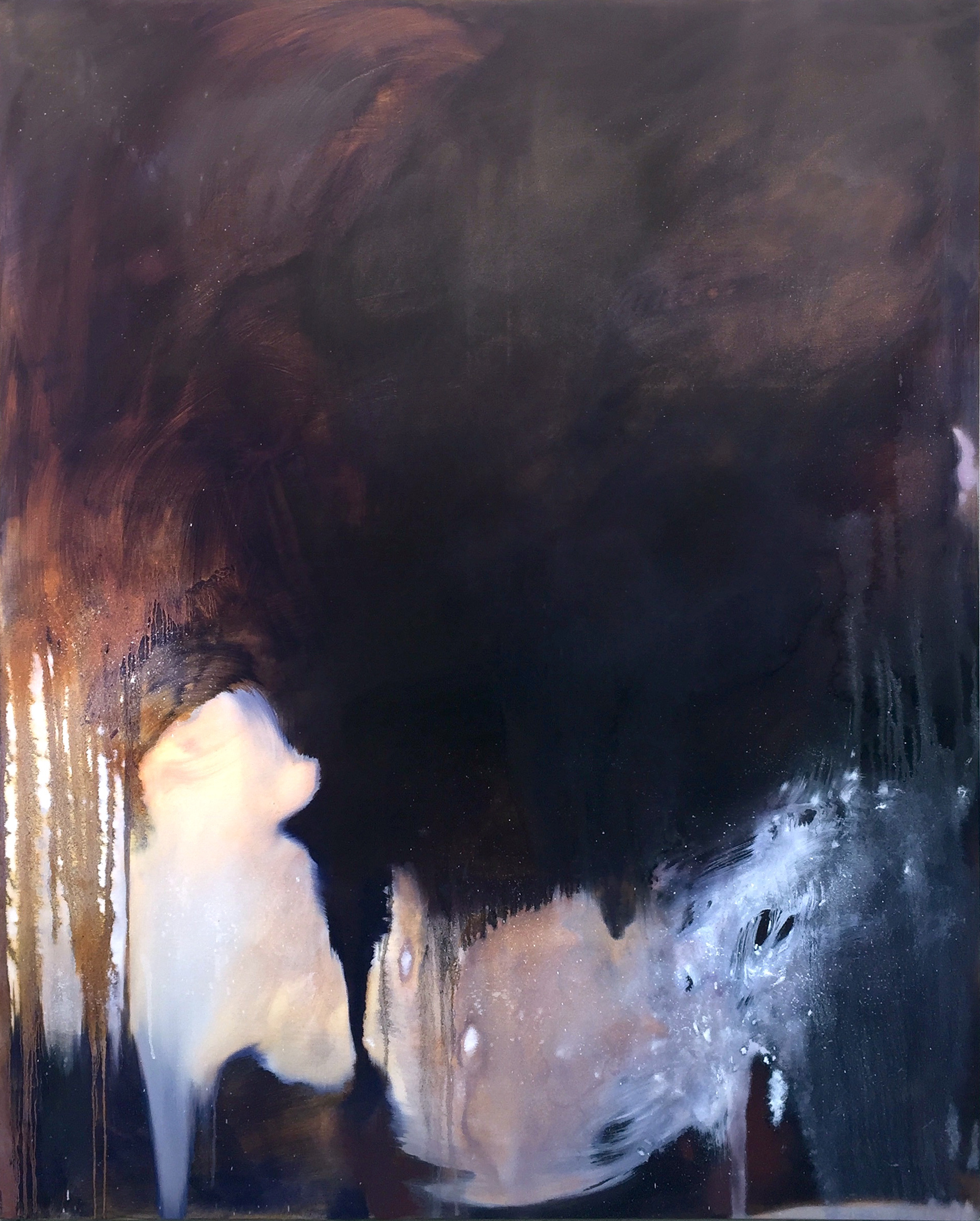
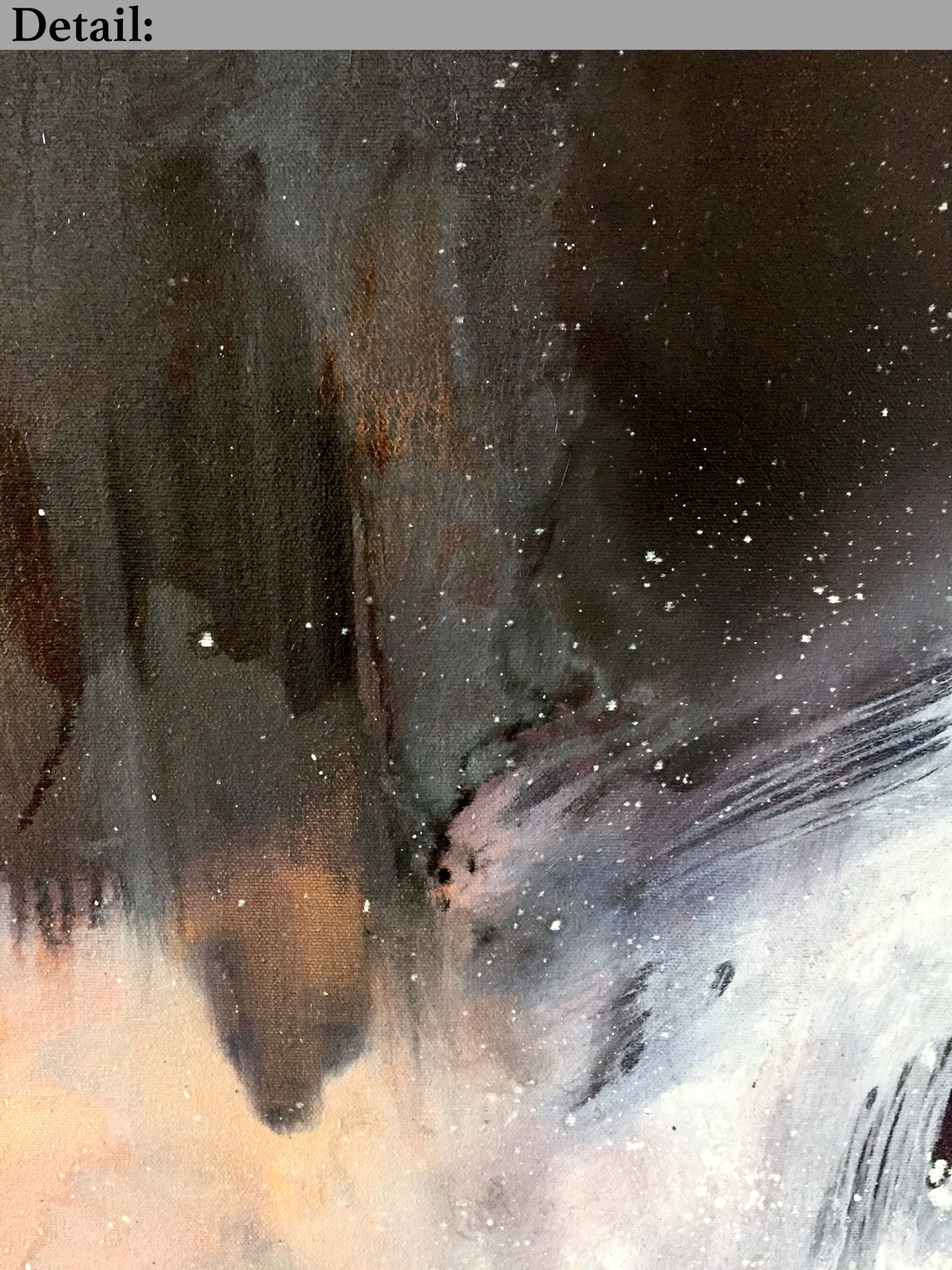
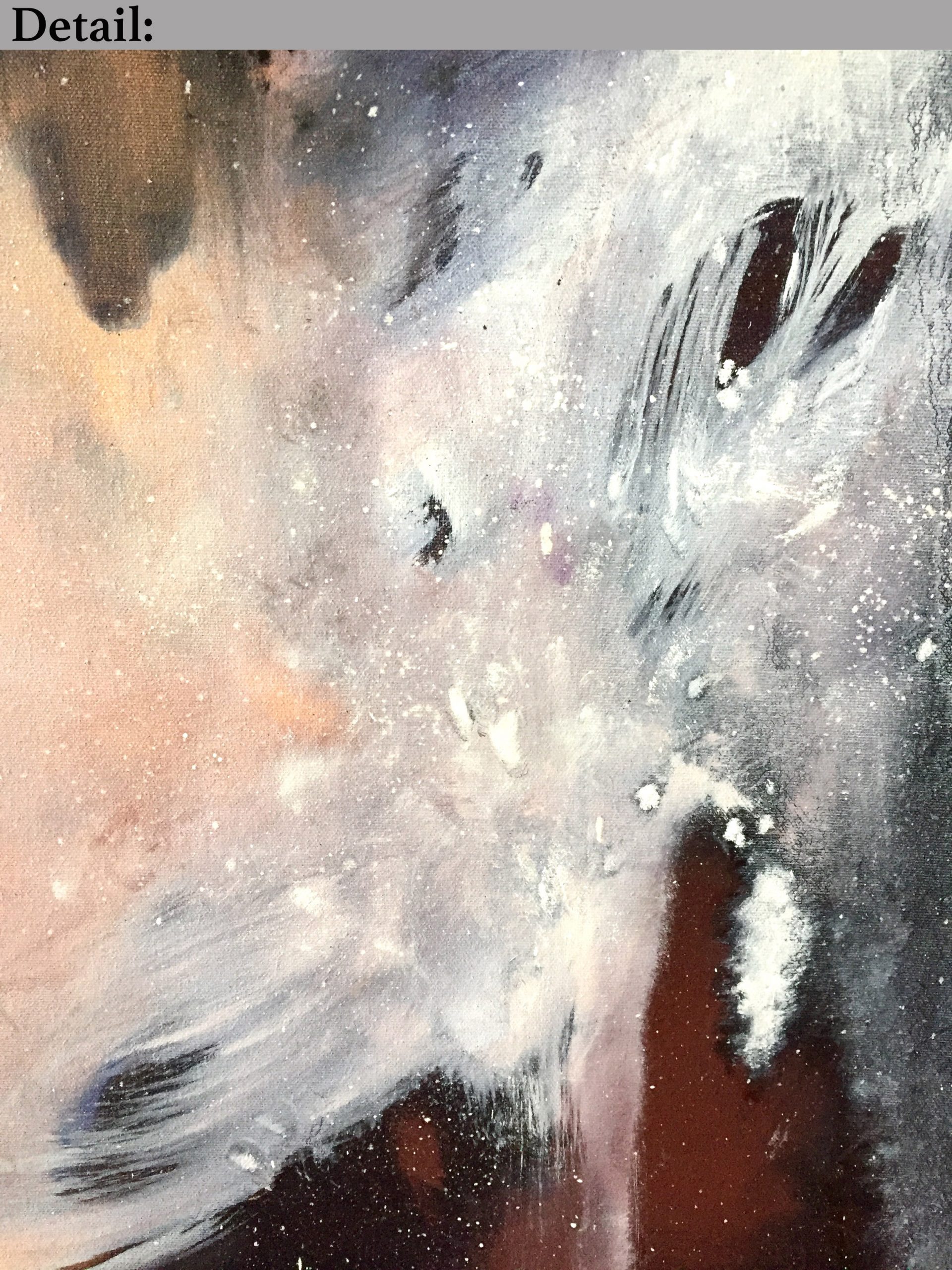
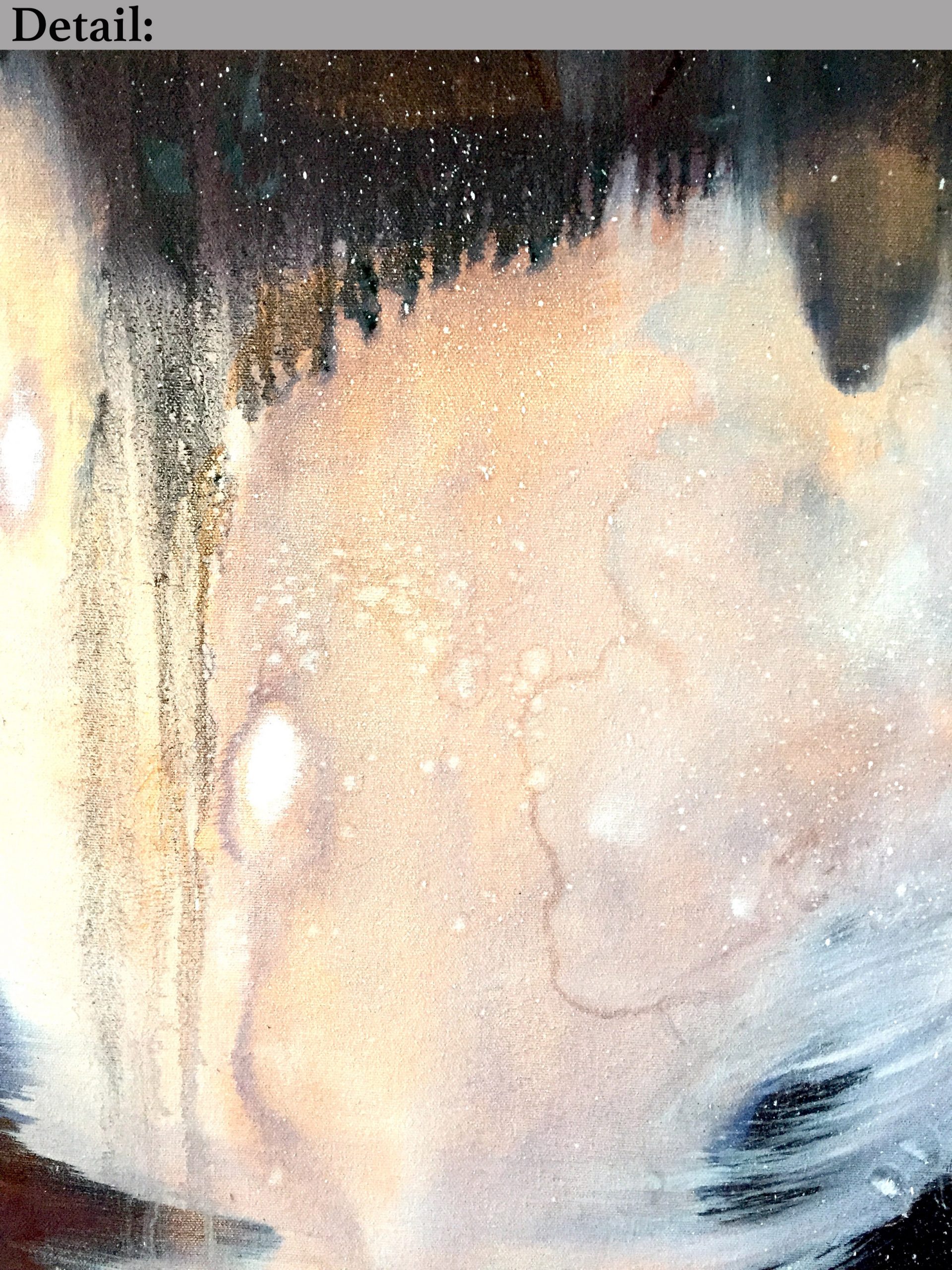
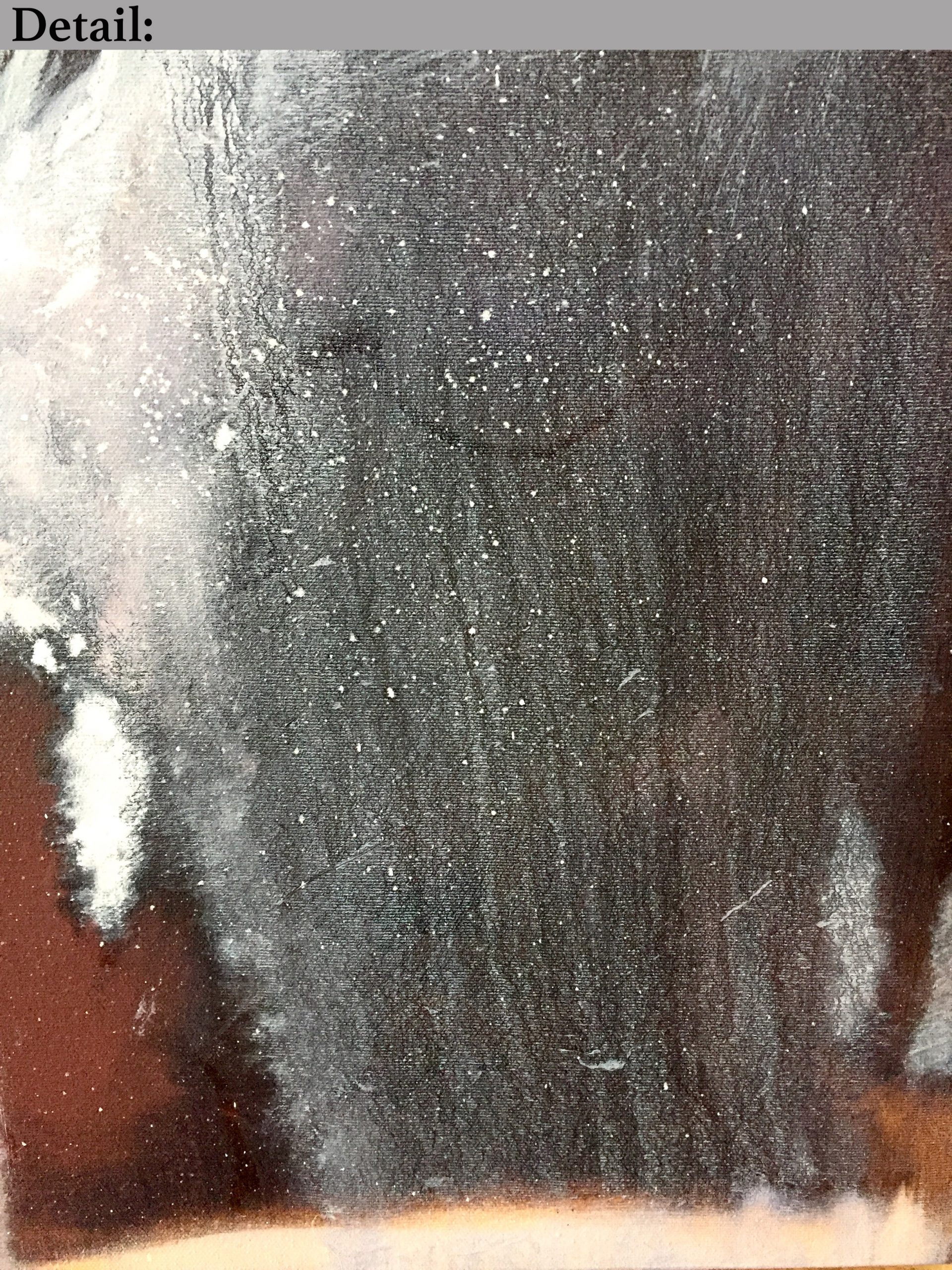
Rachel Mudrosky
4th Year, Major in Studio Arts
Untitled
48″ x 60″
Oil on canvas
2020
Artist Statement:
As a fourth-year student majoring in studio arts, I focus on figuration and abstraction in my body of work. Currently exploring performative and experimental modes of expression, my interest in work which emphasizes the materiality of an image-making process is piqued; treatment of medium and surface holds a strong significance and creates moments of tension as well as elation. I see my artmaking process as a tactile endeavor. I seek to interact with the senses, ultimately creating an image which is both visceral and sincere.
Untitled was made this year, as I am currently taking a course in abstract painting – an area of interest and uncertainty for me. Painting is a fluid and expressive process which I enjoy very much, while still feeling challenged by it to a point of deep discomfort. Regardless of how much I paint, the doubt and hesitation that might come with a first painting still lingers. Untitled represents the beginning of a turning point: The moment where this uncertainty transforms into an experimental exploration, the start of an untroubled mode of expression which focuses on process and play. Often looking at change in my greater body of work, I underline the unfixed nature of bodies and states over time through fragmentation, incompleteness, and selective rendering. This is most explicit in other works of mine which are created through the medium of drawing. Exploring this approach through abstract painting has challenged me to expand my perspectives surrounding treatment of medium and surface as I paint.
The notion of transformation is embodied through the fluid movement of forms in this painting; each one interacting with the other, reshaping with every contact. Through gestural brushwork, I seek to create a space that is both tangible and beyond reach, inviting and grim. Light pierces through darker layers, transfiguring the surface and one’s encounter with it. Striving to create images that are detailed and imprecise all at once, this inclination towards the cryptic and personal often results in work which emanates a sense of melancholia. I rely on intuitive expression as a means of creating in a genuine way, and to allow visual imagery of an otherwise inaccessible place to emerge authentically.
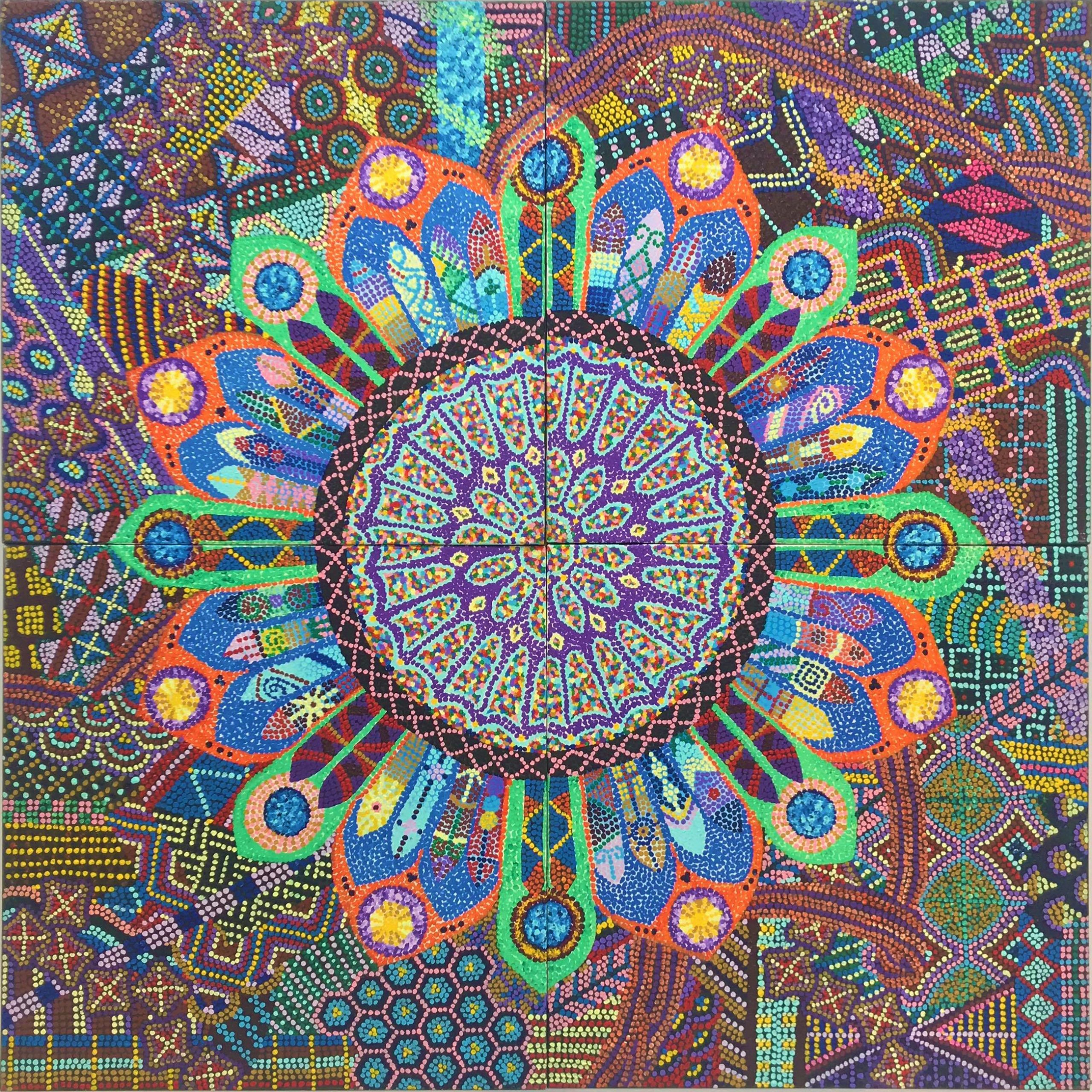
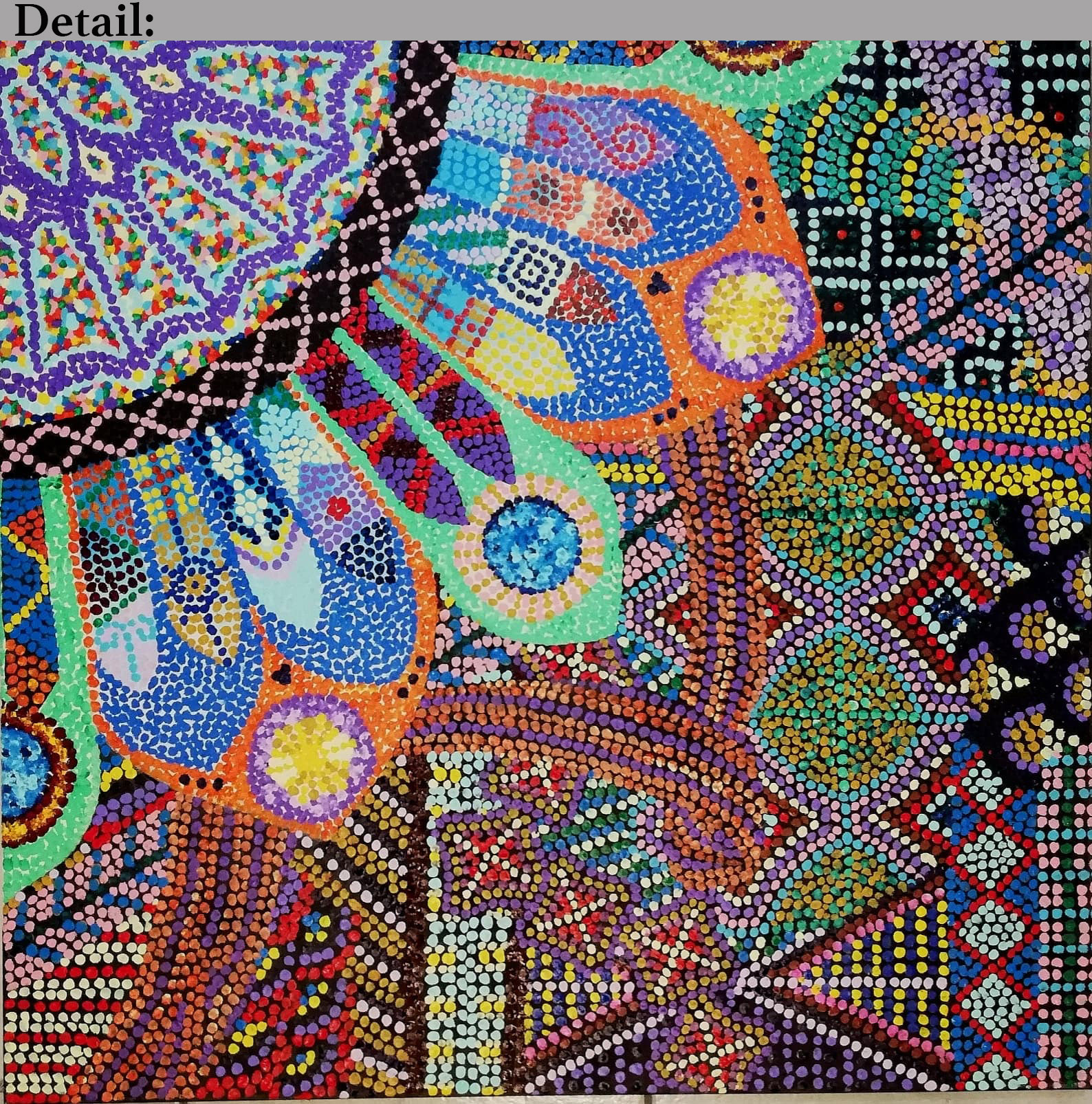

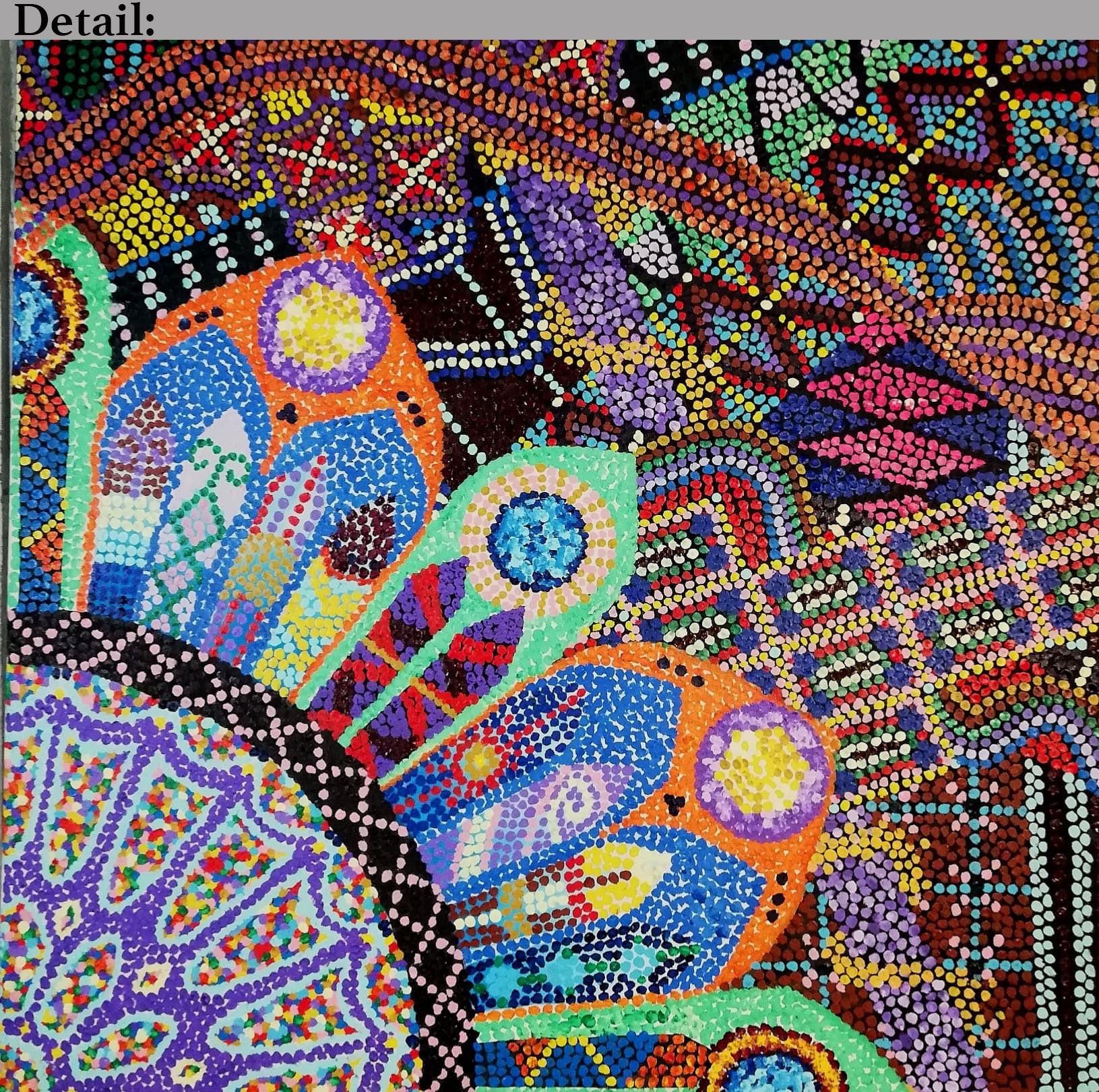
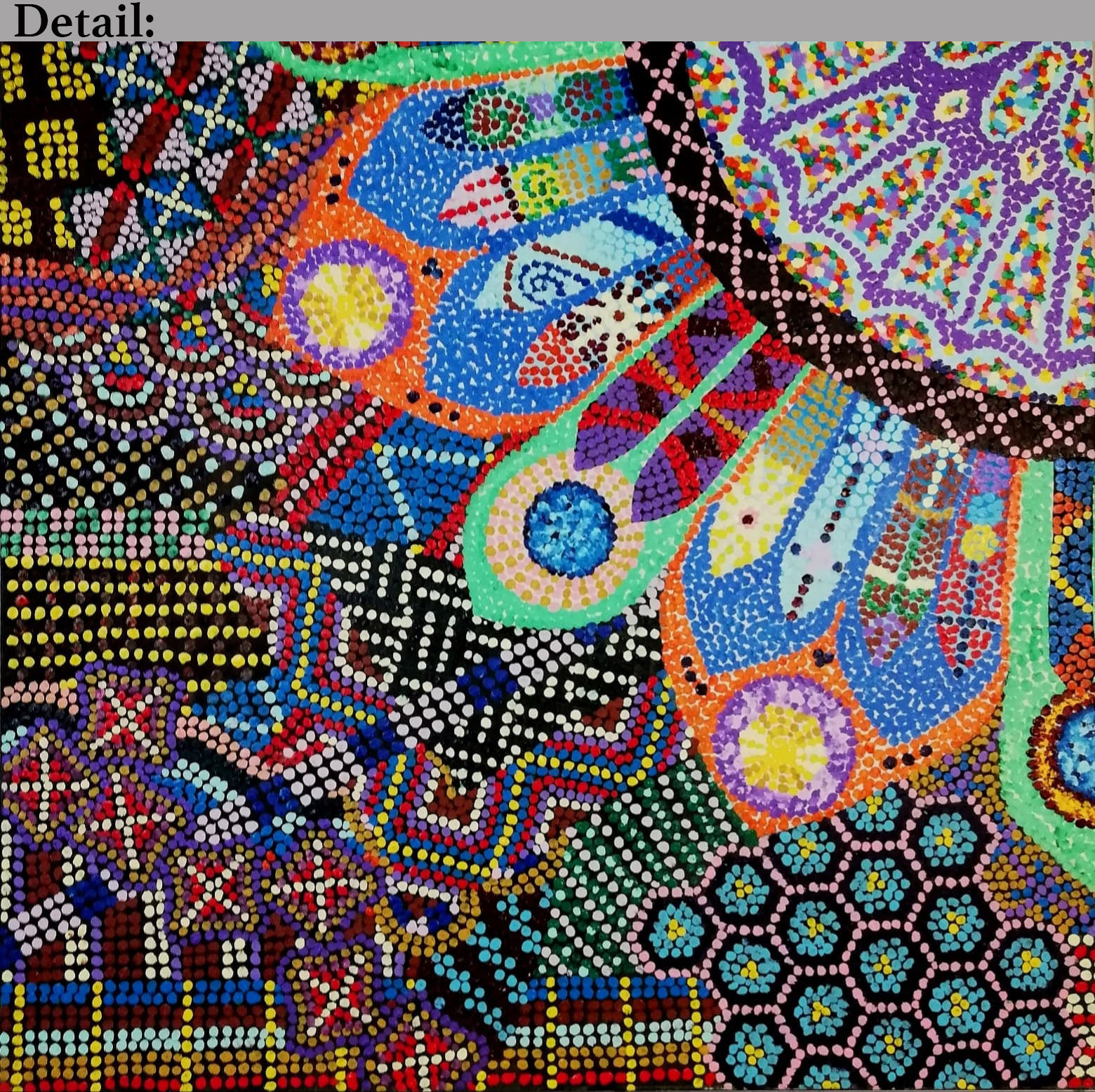
Marika Madimenos
3rd Year, Major in Studio Art and Art History
Explanations #5
Four panels, each 30″ x 30″
Total, 60″ x 60″
Acrylic on canvas
2019
Artist Statement:
This project began with a realization: I found that I was evolving in a different way compared to everyone around me. I think outside the box to solve the simplest situations, such as creating the most detailed project at school that does not even count towards a grade. I have been told that I am too negative when I prepare for any and every bad outcome. However, I see this preparation as a way to ensure that only a good outcome will occur. These comments feel similar to hearing a language that sounds familiar; you think you can speak it, but no one is actually able to hear or understand you. The central idea of Explanations #5 was to create a work which showcases a visual, abstract representation of my thought process. This work consists of four panels, each 30” by 30” and was completed in December 2019 using acrylic paints on canvas. Explanations #5 is only one part of a larger series which displays ideas and themes that everyone encounters daily: our passions, our relationship towards music, religion, sexuality, and more. No one will fully understand the inner workings of another’s mind, but this painting is meant to allow the artist and the viewers to recognize the bigger ideas which transform and shape each of us throughout the duration of our lives.
This particular work in the series represents the passion one finds through one’s life. This is why I consider it to be the most elaborate piece in the series. Details among these panels were chosen uniquely and represent my perception and views on subjects similar to what I have listed above. This series is more personal because of my choice to use pointillism throughout each panel. The seemingly endless number of little dots which make this work helps create a clearer picture. While I might find things complicated and unbearable in my own head, the thoughts as depicted with paint are never muddy. Through my choice of patterns and designs, I created an overwhelming mechanical feeling within the paintings to express that our minds and our thoughts are transforming and evolving constantly; a clear evolution hence the presence of confidently dotted colours which bear complexity, nonetheless.
There should be no shame in someone taking extra time to understand where another’s views derive from. It is very possible that this series and approach to painting will continue in my future work. I have always believed that our minds, just as our ideas and potential, are limitless; in a constant transformative state, and so this series will be as well.
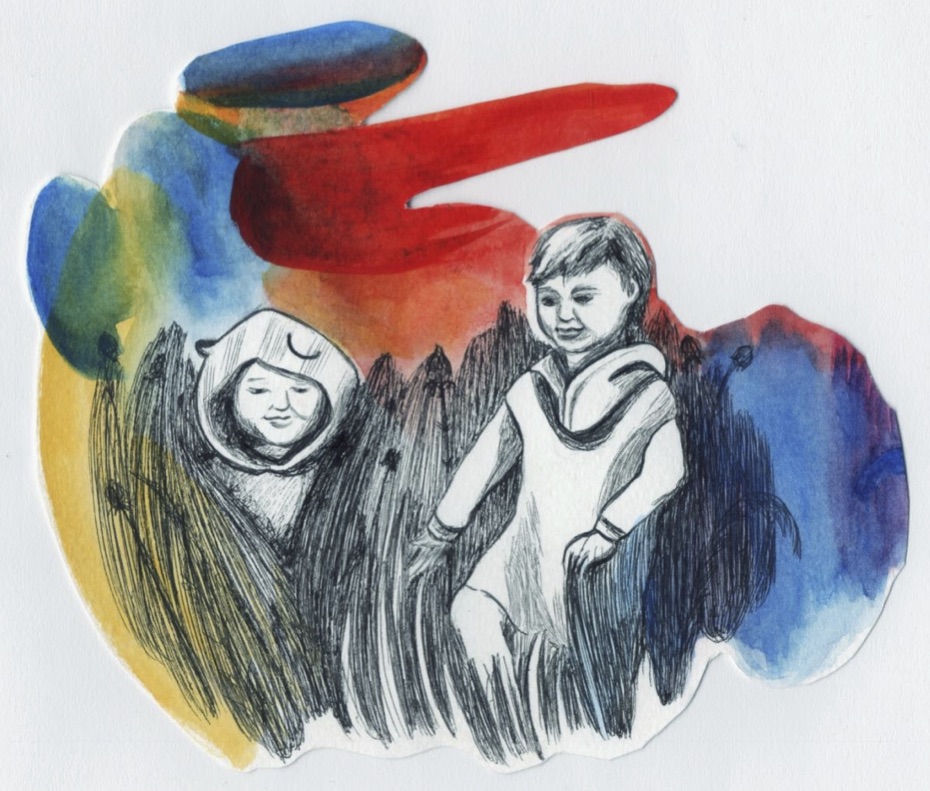
Natacha Girouard
1st year, Major in Art Education
You Can Do Hard Things
Written reflection on the act of transformation in outdoor pre-K
2019
Many types of outdoor education programs exist with varying goals, methods, and populations. My experience in outdoor education is mainly in outdoor preschools, environmental education centers, and guiding backcountry trips. I have navigated this field for the past four years with the help of fantastic teachers, peers, and a good deal of immersion. Throughout these years, I have consistently observed the changes taking place within participants and educators. Transformation took many shapes during my most recent work in 2019, with an outdoor experiential preschool company located in British Columbia, Canada.
For eight months, my role was to develop programs and act as the lead instructor. The learners’ ages ranged between two and five years-old, and most attended the program once or twice a week. We ran three-hour blocks of programming daily, as well as one six-hour block once a week with the eldest learners. The programs took place in a small town, on unceded Sinixt, Okanagan and Ktunaxa land. Our outdoor classroom included a field and reconstructed wetland as well as a small forested grove a 15-minute walk away. The natural settings and seasonal changes influenced the structure of all our programming. Our keystones included respect for each other, respect for the environment, and trying new things. Play, storytelling, and crafts were central to our day while discoveries and inquiry enhanced our routines and future programming. Running our programming mainly outdoors created some constraints but opened a lot of possibilities as well.
Week by week, learners actively transformed their environment into places filled with stories, magic, and artifacts. These were the trails and evidence of our passage. Mud, water, plants, and stones provided abundant material for crafts and inspired many games; the opportunities to experiment felt endless and learners were keen to engage with their environment. They created shelters, made potions, and built pulley-systems. During winter, learners endeavored to fill-in the cracks of tree bark with snow in order to paint them. They indulged me through participating in lessons, such as making cardboard binoculars and playdough forest creatures. Novelty was a key aspect of our programming such that no two days were alike. Planning and preparation were also important, though many activities emerged through improvisation and play. The success of the program was greatly due to engaging with our settings, which kept learners interested and curious. Simple activities opened up new interactions with the environment, enabling everyone to explore and see differently. Transformations also materialized within. The learners were learning to adapt to weather, changing environments, and being part of a group. For many families, it was also the first time they would be apart from one another for a longer period of time. For learners who had attended more traditional daycare programming, they were now adjusting to being mainly outdoors. Initially, some learners were very hesitant to try new things such as jumping in puddles with rain boots or would get easily discouraged when scrambling up a hill. A phrase used by the owner of the company to encourage learners, “you can do hard things”, sometimes fit the situation just right. We used the phrase to encourage each other when rolling down a hill or turning heavy rocks to observe the insect world which existed beneath it. I have internalized this phrase and know learners will also remember it for a long time. These days, it comes to mind when I am apprehending a new or difficult task. Working with this group turned me into a softer, humbled, more easygoing human.
We were fortunate to have access to wonderful natural spaces and learners were eager to respect and nurture them. By routinely visiting and interacting with these spaces, they were also transforming their relationship to the places in which they lived and played. For example, they frequently pointed out garbage and participated in ‘leave no trace’ practices (Leave No Trace Canada, 2009). As main users of these spaces, it was up to us to conserve them. Learners also developed a relationship with the community garden and its members by visiting and planting sunflowers. Their families would tell me about the pride their children felt in the places we’d discovered, the plants we were growing, and the shelters we had created for animals. The learners’ intense caring and identifying with place strengthened by their experiences was an extremely rich process to witness.
Reflecting on this experience raises new questions for me; how is observing and interacting with our environment relevant to art education? How are we transformed by and continuously transforming our environment right here in Montreal? What kinds of materials are readily available in cities and appropriate to use? How are we limited in our use and transformation of parks and school playgrounds? Similarities between outdoor education programs and art education became clear to me while reflecting on my experience. Both aim to create meaningful, novel, and transformative experiences for learners. Both are concerned with the individual as well as the group and fostering a sense of community. Further bridging these two worlds might involve connecting to themes of place through art lessons. Resources like community gardens, guest speakers, documentaries, inquiry-based projects, local architecture, and public art could all help deepen learners’ relationships to the place they live.
The writing of this text took place in Tiohtiá:ke/Montreal, land of the Kanien’kehá:ka Nation.
Karina Jacobsen
3rd year, Major in Studio Arts
Everything is Transformed
Written Work
2019

Everything is Transformed
With focus on the following instructions written by Yoko Ono, (1964/2000):
Cleaning Piece IV
Write down everything you fear in life.
Burn it.
Pour herbal oil with sweet scent on the ashes.
I enacted these instructions during a summer evening in 2019, at around 10:00 pm. Quickly, I wrote a list of fears on a notepad, folded the paper into an accordion and put it in a small metal bowl. I did not want to set off the smoke alarm so I grabbed a lighter and my homemade lavender spray and made my way over to the park next to my home. It was late enough in the day that the park was practically empty so I took the opportunity to choose a spot that felt right. My boyfriend came with me to witness the experience. I set the paper on fire, waited until it had finished burning, and sprayed it with lavender. My homemade lavender spray lifted the ashes and blew most of them away as I noticed the scented oil clash with the smell of smoke.
When making my list of fears for this experience, I noticed some resistance within myself. The action felt self-involved and I did not feel that I wanted to dwell on negative thoughts. Some of my fears felt profound while others felt silly and dramatic. I realized that I was judging these fears and viewed them as a measure of my inner strength. One of them almost made me cry, and if I think about it now, the feeling creeps back up.
While trying to find the right location in the darkness to burn my list of fears a number of thoughts came to mind. There was something about the act that felt ritualistic to me. The bowl that held the burning paper, the paper itself, the oil I used; in short, the elements involved in this act all felt elevated in importance. The act felt sacred, close to prayer. Even the fire took on a deeper meaning. Fire is often associated with annihilation or destruction, but I found myself thinking of it more as a symbol of purification and transformation. I recalled the law of conservation of mass first described by the chemist, Lavoisier, in the late 1800s. Following a set of experiments, he concluded that nothing is lost, nothing is created, but that everything is transformed (Sterner et al., 2011). Therefore, setting fire to this list of fears did not erase them but allowed them to be viewed differently through this creative act. Here I saw a link to Yoko Ono’s Cut Piece (1964), where the act of participants cutting away at her garment “transform[ed] acts of destruction into acts of creation” (Concannon, 2014, p.104).
In the summer of 2019, I visited a retrospective on Yoko Ono’s art at the Phi Centre. This centre is located on Saint-Pierre Street in Old Montreal and displays a diverse range of contemporary and multidisciplinary art. Like the instructions I followed initially, the retrospective contained pieces in which the viewer was encouraged to participate or interact. As a result, it is the viewers’ participation that allows the art piece to take shape, and at the same time allowing the viewers to alter or affect along the way. Through visiting the Phi Centre, I found that there were a few differences in how I followed the instruction score. I had a better understanding of the instruction score as an art form; therefore, I took my time and respected the process more: I chose a bigger piece of paper on which to write my fears in my prettiest handwriting. I repeated some of the fears I wrote previously but I added new ones. This time, I noticed my teeth clenching and my throat tightening as I wrote the fears down. I was more careful folding the paper, and I found a spot in my house which wouldn’t set off the smoke detector. I cut the paper in half to make it fit in the bowl, used a fancy matchbox, and took pictures to document the event. Unlike the previous experience, I was
more meticulous during my ceremony. I could see how naming and burning a list of fears can provide a sense of agency over them, and how adding the scented oil could be an act of compassion and reconciliation.
Yoko Ono’s work centres on the notion of peace and all that it entails (Concannon, 2014). She approaches the concept of inner peace as well as peace extending to the world around us. Although her work often focuses on the power of collective optimism, she also solicits “the full range of human emotion” (p.107) from the viewer.
I understood what this ‘full range’ was referring to when viewing Arising Testimonials (“Liberte Conquerante/Growing Freedom” exhibit at the Phi Centre, 2019), an ongoing project that collects women’s disclosures of violence committed against them. I learnt that a search for peace stems from acknowledging the reality of people’s lives; the reality that peace, for many of us, is not a given. Unfortunately, the subject of violence is a subject we as women know all too well. I was hesitant to read any of the testimonies because the imposition of my gaze felt almost voyeuristic. However, I wanted to know if I recognised any of the women. Seeing so many victims brought up feelings of revulsion, frustration, sadness, and disappointment. My interpretation of the piece is that it isolates the women on the wall as victims. I found this maddening because I found that there was nothing to counterbalance this perspective. On the other hand, I think my reaction is partly associated with the fact that the piece probably strikes a chord in most of us. Upon reflection, I see value in participating in Arising Testimonials; to feel a sense of solidarity and to take the opportunity to unburden oneself can be so cathartic for the mind, body, and soul as well. As art historian Kevin Concannon (2014) asserts, Ono’s work incorporates “honesty that recognizes reality even as it seeks to transform it” (p.107). Sometimes you cannot just think of the world positively, you also have to blatantly and openly expose the bleak parts of life in order for change to occur.
References
Concannon, K. (2014). Yoko Ono’s dreams: The power of positive wishing. Performance Research: A Journal of the Performing Arts, 19(2), 103-108, DOI:10.1080/13528165.2014.928525
Ono, Y., (2000). Grapefruit: a book of instructions and drawings. Toronto: Simon and Schuster. Sterner R.W., Small, G.E., Hood, J.M., (2011). The conservation of mass [online]. Available at: https://www.nature.com/scitable/knowledge/library/the-conservation-of-mass17395478 [Accessed 10 March 2020].
Ono, Y., (2019). Liberte Conquerante/Growing Freedom. Curated by: G.B. Kvaran and Andrieux, C., (25 Apr – 15 Sept 2019). Location: Phi Centre, Montreal. Date of visit: June 2019.